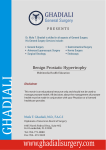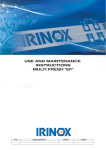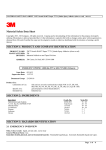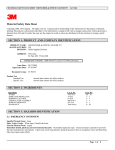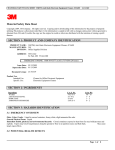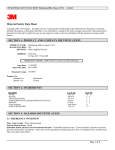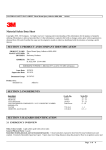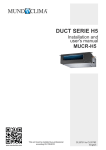Download DeLonghi CF-CP 30 ARE 290 Unit installation
Transcript
U CONTENTS I A U I A General recommendations 20 I A U I A Basic safety rules 20 I A Refrigerant circuits 29 U I A Recommendations 21 I A Indoor unit multifilar wiring diagram 29 U I A Range and accessories 21 I A Outdoor unit multifilar wiring diagram 30 I Size and weight 22 I Indoor/outdoor unit wiring diagrams 30 I Receiving the product 22 I Installation 31 I Handling 22 I Indoor unit installation 31 I Quick connector 23 I Outdoor unit installation 32 A I Connection of the units 23 I A Condensate drainage 34 I A Description of the air-conditioner 26 I A Routine maintenance 35 I A Technical data 28 U I A Extraordinary maintenance 35 I A Operating limits 28 U I A User diagnostics 36 U U COMPLIANCE I A DECLARATION OF COMPLIANCE The company: DeLonghi S.p.A. Via L. Seitz, 47 31100 TREVISO ITALY DECLARES under its own responsibility that: the AIR-CONDITIONERS Range : CF-CP AR Models : CP 20 ARE 290 CF-CP 30 ARE 290 CF-CP 40 ARE 290 are in conformity with • Low voltage Directive 73/23EEC,93/68 EEC, • Electromagnetic compatibility Directive 89/336 EEC and 92/31EEC The following symbols have been used in some parts of this booklet and inside the appliance: U I A User Attention Installer Forbidden After-sales service Danger: live parts Danger: moving blades 70°C Danger: high temperature Fire hazard U GENERAL RECOMMENDATIONS After having removed the packing, check that the contents are intact and complete. In the event of non-compliance, contact the the appliance. Agency which sold you appliances should be installed by a qualified company in accordance with the laws and regulations in force in the country of installation. Upon completion of work this company should issue the owner the declaration of compliance of installation with current regulations and standards and with the instructions given by in this booklet. These appliances have been designed to heat or cool the air of rooms and should only be used for this purpose in compatibility with their performance characteristics. Under no circumstances can be held liable for damage caused to property or injury to persons or animals due to incorrect installation, regulation and maintenance or to improper use. Too low a temperature is harmful to health as well as being a useless waste of energy. Avoid prolonged direct contact with the flow of air. Avoid the room being closed for a long time. Periodically open the windows to ensure a correct change of air. During storms put the installation on/off switch to "off". This instruction booklet is an integral part of the appliance and should therefore be carefully preserved and ALWAYS accompany the appliance, also in the event of transfer to another owner or user or into another installation. Should the booklet be damaged or lost, request a copy from the Area Service Centre. Repair or maintenance work must be carried out by the Service Centre or by qualified personnel in accordance with instructions given in this booklet. Do not alter or tamper with the appliance, since hazardous situations could be created and the manufacturer A of the appliance will not be liable for any damage or injury caused. The unit should be installed in compliance with local installation and safety regulations. For any repairs, contact only customer service centres authorised by the manufacturer. Repairs made by unauthorised personnel may be dangerous. The CP20 ARE 290 air conditioner must be used and stored in rooms with a volume of over 31 cubic metres. The CP30-CF30 ARE 290 air conditioner must be used and stored in rooms with a volume of over 53 cubic metres. The CF40 ARE 290 air conditioner must be used and stored in rooms with a volume of over 53 cubic metres. Non-ventilated environments where an appliance containing flammable refrigerant is used must be compatible, to avoid the possibility of a gas leak reaching a level of concentration such as to cause a fire or explosion resulting from the presence of other heat sources (electric heaters, stoves or similar units). The R 290 refrigerant charge is highly flammable, and could cause an explosion in the event of leaks occurring in closed or poorly-ventilated areas. This gas is heavier than air and invisible, but it generates a mist if there is humidity in the air. Avoid contact of the liquefied gas with eyes or skin as it could cause injuries. Transportation, charging, cleaning, recovery and disposal of the refrigerant should be carried out only by customer service centres authorised by the manufacturer. Disposal of the appliance should be carried out only by specialised personnel authorised by the manufacturer. U BASIC SAFETY RULES Using electrically-operated products implies the observance of certain basic safety rules, such as those given below: I I A ted to the air-conditioner, even if disconnected from the mains electricity supply. Do not sit or stand on the appliance or rest anything at Children and unassisted handicapped persons are not all on top of it. allowed to use the air-conditioner. Do not spray or throw water directly onto the air-condi- Do not touch the air-conditioner when barefoot or parts tioner. of the body are wet or damp. Do not introduce sharp, pointed objects through the air Do not carry out any cleaning operation until the air- intake or outlet grilles conditioner has been disconnected from the mains Do not access internal parts of the air-conditioner electricity supply by putting the installation on/off swit- without having first put the on/off switch to "off". ch to "off". Do not leave the packing material (cardboard, staples, Do not alter the safety or regulating devices without the plastic bags, etc.) within reach of children, but dispose permission and instructions of the manufacturer of the of properly since it is a potential source of danger. air-conditioner. Do not pull, detach or twist the electric cables connec- English U I A RECOMMENDATIONS Extraordinary maintenance Programmed maintenance always represents a saving in the running of the installation as well as preventing possible faults. To ensure trouble-free operation of the air-conditioner, it is recommended that it be inspected at least once a year, carrying out the following checks: - cleanliness of the heat exchange coils of both units Exposure control/personal protection Use protective clothes and suitable gloves; protect eyes and face. Handling Avoid inhaling high concentrations of vapors. The atmospheric concentrations should be reduced to a minimum and kept below the professional exposure limit. The vapors are heavier than air and high concentrations may therefore form near to the ground, where general ventilation is poor. Under such circumstances, ensure there is adequate ventilation. Avoid contact with naked flames and hot surfaces, otherwise irritating and toxic decomposition products could form. Avoid the liquid from coming into contact with eyes or skin. Precautions to take in the event of accidental spillage Ensure adequate personal protection (using protective breathing equipment) during elimination of spillage. If conditions are sufficiently safe, isolate the source of the leak. With small leaks or spills and provided there is adequate ventilation, let the material evaporate. With copious leaks or spills, adequately ventilate the area; keep the material from expanding using sand, earth or other suitable absorbent material. Prevent the liquid from entering into drains, sewers, cellars or work holes, since the vapors could create a suffocating atmosphere. First aid measures Inhalation - Remove the casualty from the area of exposure and keep him/her warm and still. Ask for immediate medical aid. Contact with the skin - Thaw the involved parts with water. Remove contaminated clothes, which could stick to the skin in the event of cold burns. In the event of contact with the skin, immediately rinse with abundant lukewarm water. Should there be symptoms of irritation or blisters, ask for medical aid. Contact with the eyes - Bathe immediately with an eyewash solution or clean water, keeping the eyelids wide apart for at least ten minutes. Ask for medical aid. Swallowing - Do not provoke vomiting. If the casualty is conscious, make him/her rinse out his/her mouth with water and drink 200-300 ml of water. Ask for immediate medical aid. Other medical care - Symptomatic and back-up treatment as required. Do not administer adrenaline or similar sympathomimetic medicines following exposure, due to the risk of cardiac arrhythmia. ATTENTION For further information on the characteristics of the refrigerant fluid, refer to the safety data sheets available c/o the refrigerant manufacturers. spa cannot be held liable for any errors in this booklet and reserves the right to alter the specifications of its products without notice. U I A ACCESSORY Condensate drainage pipe ø 16 - 50 m. Activated carbon filters (1 pc.) Wall bracket Gold Wall bracket Silver Condensate drain pump RANGE AND ACCESSORIES Model Code 20÷30 20÷30 20÷30 552626 552929 552632 5572002700 552627 M English I SIZE AND WEIGHT INDOOR UNIT Model L H P Weight 20 810 300 195 9 30 810 300 195 9 40 967 300 195 11 L H P OUTDOOR UNIT Model L H P Weight A B 20 660 500 230 34 420 264 30 660 500 230 35 420 264 L 40 800 640 280 52 550 310 H P A RECEIVING THE PRODUCT The air-conditioner comes in two packs protected by cardboard packaging and is accompanied by: - Instruction booklets for the user and the installer. - Warranty certificate. - Bar code labels. - Supplied accessories, which are contained in a plastic bag to be found inside the indoor unit pack. The instruction booklets are an integral part of the airconditioner and should therefore be carefully read and preserved. HANDLING The air-conditioner should be handled by suitably equipped personnel using equipment that is suitable for the weight of the appliance. English B I It is advisable to remove the packing only when the airconditioner has been located in the point of installation. Carefully remove the adhesive strips positioned on the air-conditioner Packaging components must be disposed of correctly and not left within reach of children since they are a potential source of danger. I During transportation the outdoor unit must be kept in an UPRIGHT position. I QUICK CONNECTOR Components description A. B. C. D. Liquid line (high pressure) Vapor (low pressure) Cover Electrical I CONNECTION OF THE UNIT BASIC OPERATION The fast connector coupling uses a retractable sleeve and stem valve on the female half and a spring loaded poppet on the male side to create a safe, clean and quick Female separation of split air condotioning system with minimal fluid loss and air inclusion (see Figure 1). Fig. 1 Male English I CONNECTION OF THE UNIT No tools are required to connect the coupling: a retractable sleeve and four latch pins hold the male and female halves together. The coupling valves open when the handle is pushed forward and locked into place, and shut when the handle is in the “full back” position (see figures 3-4). Fig. 2 Fig. 3 Fig. 4 TO CONNECT - With the coupling handle in the “full back” position (Figure 5), retract the release sleeve on the female and insert the male half into the coupling. Make sure the insertion tab on the male half lines up with the slot on the female body (see Figure 5). - Realease the retractable sleeve to lock the halves together and tug gently on the halves to ensure locking has taken place (Figure 3). - Rotate the coupling handle towards the male half to open the coupling. Make sure the handle bottoms on the Fig. 5 English coupling body and the locking pin (on models equipped with spring loaded locking pins) “pops” into the handle hole properly (see Figure 4). - Connect the auxiliary electrical and condensate lines, if applicable. - Connect the male and female caps together, if provided, to keep them clean while the unit is in operation and they are disconnected from their appropriate halves. - Connect unit to power outlet and start the unit. I CONNECTION OF THE UNIT TO DISCONNECT - Shut off the air conditioning unit and unplug the unit from the power outlet. - Wait five minutes for line pressures to equalize. - Disconnect the auxiliary electrical and condensate lines, if applicable. - On couplings equipped with spring loaded locking pins, depress the pin until it clears the coupling handle is pulled up. When the handle clears the locking pin, pull coupling handle to its “full back” position (see Figure 3). - Retract the spring loaded release sleeve on the female and remove the male half (see Figure 5). - Install the caps on both halves, if provided. Close the handle on female half after installing the cap. immediatly upon disconnection with the optional caps as shows in Figures 6 & 7. - Don’t tamper with the valves while disconnected or allow children access to disconnected couplings. - Don’t drop coupling half on any hard surfaces. The male half is made of brass and if allowed to drop may become damaged beyond the point where it can be reconnected. Installing caps immediatly after disconnection will minimize the possibility of damage if dropped. - Do not open the coupling handle while the air conditioning unit is operating. After shutting off the air conditioning u n i t , wait five minutes before opening the coupling in order to equalize line pressures. Opening the coupling during airconditioner operation may damage the compressor. DO’S AND DON’T’S - Thoroughly check the coupling for proper position of seal (see Figure 1), missing seals, leaking valves, debris, proper mounting, or other damage prior to reinstalling and restarting the air conditioner. Don’t use a damaged coupling. - Always keep the couplings connected even when the system is not in use in order to minimize refrigerant effusion, coupling damage and the entry of dirt or other foreign material. If it is not possible to keep the couplings connected, then both halves should be capped Fig. 7 Fig. 6 The length of the pipe connecting the internal unit to the external one is 4 m. English U DESCRIPTION OF THE AIR-CONDITIONER I A alternating current; it ensures high performance, efficiency and low noise operation. The speed may be changed according to needs. The heat exchanger has a large surface area and consists of scored copper pipes and swirl-type aluminium fins. Regulation, control of functions, data interchange with the outdoor unit and diagnostics are governed by a microprocessor card. The air-conditioner is an appliance designed for small user systems. It consists of an indoor unit for wall mounting and an outdoor unit. REMOTE CONTROL The infrared remote control is used for function control, regulation and programming; its operating modes and use are described in the user booklet. INDOOR UNIT The indoor unit housing is plastic. The electric fan unit consists of a tangential fan powered by 1 CF 20 ARE 290 / CF-CP 30 ARE 290 CF-CP 40 ARE 290 45 2 3 6 4 8 7 9 25 10 22 5 11 12 26 27 24 13 28 31 30 29 14 22 32 33 34 23 36 35 15 41 44 42 47 46 1 2 3 4 5 6 7 8 9 10 11 12 13 14 Wall-mounting plate Indoor unit base Indoor fan motor Sensor unit Room sensor support Card support box Noise filter Fan capacitor + transformer Electronic card Cover Mode push button Cover Sticker Air filter English 15 16 17 18 19 20 21 22 23 24 25 26 27 28 Air filter Flaps motor l.h. shell Flaps motor r.h. shell Flap gear Flap gear Flap gear Flap motor Receiver-led card Tamperproof grille Fan support Fixing angle bracket Fan rubber grommet Plastic fan bushing Fan 29 30 31 32 33 34 35 36 37 38 39 40 41 Drain pipe Finned coil Flaps connecting rod/intermediate control Vertical flaps Condensate collecting tray Remote control White cowl Logo tab Bushing Bushing Lower louver Upper louver Front grille 42 43 44 45 46 47 Strip Bushing Louver Pipe fixing bracket Quick male coupling Connection tube U I A DESCRIPTION OF THE AIR-CONDITIONER OUTDOOR UNIT The high efficiency sliding-vane compressor is on double vibration-isolation flexible mountings and is activated by an electric motor powered by alternating current and fitted with an overload cutout. The large surface area exchange coil consists of scored copper pipes and aluminium fins. The air-conditioner is commanded and controlled by an electronic microprocessor system. The electric fan unit consists of an axial flow fan in plastic and an electric motor powered by alternating current. 103 110 105 112 134 102 100 109 108 111 106 107 111 104 101 113 114 115 132 133 118 116 117 119 121 122 128 129 125 123 127 124 120 126 130 131 100 101 102 103 104 105 106 107 108 109 110 111 111 Right handle Left handle Filter Fan breakaway starting capacitor Compressor Compressor cap. Compr. protection Compr. gasket Compr. cap 4-way valve coil 4-way valve Pipe closing panel Pipe closing panel + r.h. handle 112 113 114 115 116 117 118 119 120 121 122 123 124 125 Cable clamp Compressor insulated cover Compressor insulated cowl Quick female coupling Lower rubber plug Upper rubber plug Fan support Fan flow nozzle Back Base Metal foot Vibration isolation foot Finned coil Plug 126 127 128 129 130 131 132 133 Condensate drainage union Fan Fan shock-absorber Front Front grille Spring Vibration-damping grommet Insulating cowl English U TECHNICAL DATA CP 20 ARE 290 V/f/Hz Btu/h W Kcal/h W A Power supply Cooling capacity Consumption Current requirement E.E.R. Dehumidifying Heat output A CP 30 ARE 290 CF 40 ARE 290 CP 40 ARE 290 230/1/50 12000 3500 3020 1050 5,7 3.20 1.5 12000 3530 3030 1055 6 3.34 420 17000 5000 4310 1650 7.6 3.03 2.2 600 16320 4800 4137 1570 7.6 3.0 1.9 19720 5800 5000 1860 8.1 3.11 600 650 37 650 37 8013 2350 2025 740 3.9 3.18 1.3 8422 2470 2130 690 3.5 3.57 200 12000 3520 3035 1090 5.7 3.23 1.5 420 m3/h dB(A) mm mm mm kg 450 35 550 36 810 300 195 9 580 36 9 11 11 m3/h dB(A) mm mm mm kg 1350 4 1400 45 660 500 230 35 1600 46 2100 46 2500 47 l/h Btu/h W Kcal/h W A Consumption Current requirement C.O.P. Quantity of R290 refrigerant INDOOR UNIT Air flow Sound level Size: length height depth Indoor unit weight OUTDOOR UNIT Air flow Sound leve Size: length height depth Outdoor unit weight SPECIFICATIONS Thermostat Timer Electronic defroster LCD remote control Microcomputer Electronic diagnostics Automatic night function Fan speed CF 30 ARE 290 I g 8 35 967 300 195 800 640 280 35 51 52 • • • • • • • 3 + silent Performance is referred to the following conditions:: - Cooling - Heating indoor unit inlet air temperature 27°C d.b., 19°C w.b. external air temperature 35°C d.b., 24°C w.b. indoor unit inlet air temperature 20 d.b., 15°C w.b. external air temperature 7°C d.b., 6°C w.b. I OPERATING LIMITS Operating cycle Cooling Heating English Room air temperature MIN MAX 32°C d.b./23°C w.b. 21°C d.b..16°C w.b. 15°C d.b. 27°C d.b. External air temperature MIN MAX -10°C d.b. 43° C d.b. -10°C w.b. 18°C w.b. A I A REFRIGERANT CIRCUITS Heating/Cooling Cooling HEATING COOLING Legend Condenser coil Cooler coil General filter Throttling part (capillary) Quick coupling Compressor I A Check valve INDOOR UNIT MULTIFILAR WIRING DIAGRAM BLUE YELLOW BLACK BLACK TC1 RED A2 123456 GREEN WHITE BLUE VIOLET VIOLET VIOLET VIOLET VIOLET WHITE BLUE VIOLET SB1 SW IR 12VAC HALL BLACK WHITE RED BLUE VIOLET WHITE WHITE BLUE VIOLET VIOLET VIOLET VIOLET VIOLET M1 ID1 1 2 3 FLAPS BLUE PINK YELLOW ORANGE RED XS1 BLUE BLACK BROWN BLUE BLACK BLACK ID2 M2 XS2 ST2 ST1 RED 9 8 7 6 5 4 3 2 1 +5V HALL WHITE SENSOR OUT BLACK KA1 Unit power card Infrared receiver and leds card EMC noise filter Room temperature sensor Exchanger temperature sensor Compressor relay Indoor fan motor Stepping motor for flap Manual operation key Transformer for card power supply Transformer power supply connector Motor M1 power supply connector Quick connector Power supply terminal board 3 2 1 3 2 1 1 2 3 BT2 LEGEND A1 = A2 = A3 = BT1 = BT2 = KA1 = M1 = M2 = SB1 = TC1 = XP1-XS1 = XS2-XP2 = XS3 = XT1 = XP2 XP1 BT1 Reversing valve PUMP AUX 1 4 WAY IN F OUT F L L-FUS BROWN BLACK ORANGE BROWN BLACK L L RED PT A1 (1) BLUE BLUE (3) BROWN LINE C FAN MOTOR A3 (2) BLACK BROWN POWER SUPPLY 2 1 N BROWN BROWN 4 3 2 1 XT1 BLUE YE-GR 3 BLUE BLUE YE-GR YE-GR XS3 English I OUTDOOR UNIT MULTIFILAR WIRING DIAGRAM A (1) Cooling only model XS1 Z1 FR1 4 C XS1 2 4 M1 C2 M 2 BLUE 1 C1 S RED FR1 Z1 1 R BLACK C S M1 R 3 XT2 YELLOW/GREEN 6 3 YELLOW/GREEN BROWN C2 5 C1 BROWN BLACK 6 BROWN 1 2 3 BLUE 5 BLACK YELLOW/GREEN XT2 6 5 4 (2) Heat pump model C S 4 RED FR1 FR1 2 4 BLACK 1 M1 3 C 2 XT2 YELLOW/GREEN YELLOW/GREEN YB1 5 Z1 BROWN C2 M1 YB1 M C1 6 C2 1 C1 S BROWN BLACK R BLACK BROWN 3 BLACK BLUE YELLOW/GREEN 6 5 XT2 1 2 3 3 N 6 7 = = = = = = = = R BLACK XS1 XS1 Z1 6-way female connector (front view) Compressor power supply Fan motor power supply (1) N.C. (free) (2) Command line reversing valve Neutral Earth N.C. (free) N.C. (free) XS1 FR1 Z1 C1 M1 C2 XT2 YB1 = = = = = = = = Female connector Overload cutout (compressor)) Compressor Compressor start and run capacitor Fan motor M1 capacitor start and run Terminal board for earth Reversing valve INDOOR/OUTDOOR UNIT WIRING DIAGRAMS Cooling/Heating Indoor unit Unit‡ interna N 3 2 Outdoor unit Unit‡ esterna English 1 I A I INSTALLATION The place of installation should be established by the installation designer or by a technically competent person and should take into account technical requirements as well as relevant current laws and regulations, which envisage the obtaining of specific permits (e.g. town-planning, architectural, fire, environmental pollution regulations, etc.); it is therefore advisable to apply for and obtain the necessary permits prior to installing the air-conditioner. I The air-conditioner should be installed by a qualified company in accordance with relevant laws and regulations in force in the country of installation. Before commencing installation, establish the position of the indoor and the outdoor unit, taking into consideration the minimum technical spaces, maximum length of the refrigerant lines and the difference in level between the appliances. INSTALLATION OF THE INDOOR UNIT The indoor unit should be wall-mounted. It should be positioned so that the treated air may circulate freely throughout the whole room, while observing the mini- NO y;y;y;y;y;y;y;y;y;y; y ; y;y;y;y;y;y;y;y;y;y;y;y; y;y;y;y;y;y;y;y;y;y;y;y; y;y;y;y;y;y;y;y;y;y;y;y; y; y; y; y; y; y;y;y;y;y;y;y;y;y;y; y ; y;y;y;y;y;y;y;y;y;y;y;y; y;y;y;y;y;y;y;y;y;y;y;y; y;y;y;y;y;y;y;y;y;y;y;y; y y y y y ; ; ; ; ; y y y y y y ; ; ; ; ; ; y;y;y;y;y;y;y;y;y;y;y;y; y;y;y;y;y;y;y;y;y;y;y;y; y;y;y;y;y;y;y;y;y;y;y;y; y;y;y;y;y;y;y;y;y;y;y;y; y;y;y;y;y;y;y;y;y;y;y;y; YES mum spaces necessary for technical and maintenance operations. 50 mm 50 mm 50 mm Recommended installation height is between 1.80 and 2.40 m from the ground. Water connections Prior to installing the air-conditioner, decide the direction of the outlet pipes; they may be arranged in any of the five directions indicated in Fig.(8): 1. to rear right 2. to right 3. downwards 4. to left 5. to rear left Fig. 8 4 2 1 3 5 Positioning the fixing plate Fig. 9 L 21 mm 102 mm H 102 mm A - Remove the steel fixing plate on the unit back - Rest the cardboard reference template, supplied in the kit, against the wall - Position the steel fixing plate in the area outlined by the cardboard reference template - Make sure the steel fixing plate is level, using a spirit level or a plumb line - Secure the steel fixing plate using the 5 screw anchors and relative screws provided in the kit - Should the refrigerant, electrical and condensate drainage lines exit from the rear in direction “1” or “5”, make the hole in the wall using a ø 68 mm bit, complying with the distances indicated in the figure to the side Fig. (9). 86 mm B 80 mm Steel plate B Overall dimensions Cardboard template English I INSTALLATION OF THE INDOOR UNIT - The hole in the wall should be made sloping downwards in order to aid the natural flow of the condensate water, observing the indications given in Fig.(11). - Having completed all the operations for installing the steel fixing plate, remove the reference cardboard template. - Position the pipes according to the direction required, bending them properly in order not to cause kinks in the actual pipes. - To position the pipes for directions “1” and “2” Fig.(10), they must be rotated to the required direction. - Avoid bending the copper pipes several times in the same point, otherwise they could be damaged. - Remove the unions and the rubber plugs from the indoor unit refrigerant circuit fittings only at the moment of connecting to the outdoor unit. - If the outlet direction is “2”, “3” or “4”, use a pair of pliers to remove the relative plastic knock-out on the unit. Fig. 10 2 4 1 Model L H A B Fig. 11 3 5 20 810 300 52 85 30 810 300 40 138 40 967 300 40 138 y ; ; y ; y y;y;y;y;y; 2 ~ 5 mm ;;;;;; ;;;;;; ;;;;;; Positioning the indoor unit on the steel fixing plate After having connected the indoor unit to the outdoor unit connecting pipes, proceed as follows: Fig. 12 - Attach the indoor unit to the steel fixing plate by means of the relative slots on the back of the air-conditioner Fig.(12). Attach here Attach here - Then press the indoor unit firmly onto the fixing plate, ensuring that it is secured by the spring catch designed for the purpose. For further safety, after having attached the indoor unit to the previously fixed steel plate, it is advisable to make another two holes in the wall and secure the unit using the spacers and the screws provided in the kit. To facilitate drilling operations, it is advisable to fix the unit onto the fixing plate, lift the front part and mark the drilling points on the wall through the relative holes. Fig.(13). Fig. 13 Spacer Screw ø 6 mm screw anchors I INSTALLATION OF THE OUTDOOR UNIT The outdoor unit should be put in a position that guarantees the minimum space for sufficient air circulation and to allow maintenance work and the connections of electrical and refrigerant circuit lines. It may be installed on a floor or flat roof or wall-mounted, provided its weight is properly supported and there is no transmission of vibration to the adjacent rooms. It is advisable to avoid: - installation in cavities or air vents; - installation where obstacles or barriers could cause recirculation of the expelled air; - installation in places with an aggressive atmosphere; - installation in confined places in which the sound level of English - - - the outdoor unit could be increased by reverberation or resonance; installation in corners where dust, leaves or anything else usually collects, which could reduce the efficiency of the air-conditioner by obstructing the passage of air; installation in places where the air expelled by the outdoor unit could enter the inhabited rooms through windows or doors, thereby causing discomfort to those inside; installation in a place where the air expelled from the outdoor unit is against a prevailing wind; installation in a place that is in direct sunlight. I Installation of the outdoor unit drain line (if available) INSTALLATION OF THE OUTOOR UNIT Fig. 14 A During operation in the heating mode, the condensate water may be drained from the outdoor unit through three drain holes. Insert the drain male fitting into the hole where drainage of the condensate water is required and plug the remaining two holes using the plugs B supplied in the kit, as shown in Fig.(14). B C FLOOR INSTALLATION D Installation on a floor or flat roof does not necessitate fixing the feet to the floor. The feet should instead be placed on supports (~70÷80 mm) to allow application of the condensate drain line (for units with heat pump only). Fig. 15 10 0m m The minimum distances shown in the figure should be observed. Fig.(15). 200 0m SUSPENDED INSTALLATION m The minimum spaces indicated should be observed for suspended installation, which requires a support kit that must be ordered separately. Carefully check the structure and the capacity load of the supporting wall. Fig.(16). mm 10 100 mm Fig. 16 English I ; ; ; ;; ; ; ;;; The indoor unit is fitted with a condensate drain pipe, to which a drainage hose (ø inside 16 mm) should be connected leading to a suitable drainage outlet. Fig. 17 Protection - Fasten the condensate drain pipe to the refrigerant pipes with adhesive tape whenever the lines cross through a wall; this is to prevent the condensate drain pipes from being flattened. Fig.(17) - Fig.(18). - In the summer mode of operation, check that the condensate is flowing out regularly. Drain pipe Drain pipe extension Fig. 18 The drainage pipe should have a 2° slope down towards the drain; it should never slope upwards. ;;;; CONDENSATE DRAINAGE Pipework ;;;;;;; ;;;;;;; ;;;;;;; ;;;;;;; ;;;;;;; ;;;;;;; Installation place Check all the joints for leaks. Drain pipe Power supply cable - The condensate drain pipe should be inserted onto the coupling located on the bottom left part of the indoor unit. English Fig. 19 Insulating tape y;yy;;y;y;y;y;yy;;y;y;y; y;y;yy;;yy;;y;yy;;yy;;y;yy;;yy;;y;yy;; y;y;yy;;yy;;y;yy;;yy;;y;yy;;yy;;y;yy;; y;y;yyy;;;yy;;y;yyy;;;yy;;y;yyy;;;yy;;y;yyy;;; y;y;y;yy;;y;yy;;yy;;y;yy;;yy;;y;y; Apply thermal insulating material to the joints. Fig.(19). U I A ROUTINE MAINTENANCE ON Do not carry out any cleaning operations until you have disconnected the air conditioner from the power supply by setting the system’s main switch to “OFF”. CLEANING THE INDOOR UNIT The appliance should be cleaned using a slightly damp cloth. Dry it with a dry cloth. For safety reasons, do not use water to clean the air conditioner. Caution Do not use gasoline, alcohol or solvents for cleaning. Do not spray insecticide or similar products on the unit. CLEANING THE AIR FILTERS To ensure the long life and efficiency of your air conditioner follow these instructions: 1. Clean the dust filter once a week. 2. Replace the purifying filter (if any) at the end of each season, or when it is exhausted (follow the instructions posted on the appliance next to the filter seat). The air purifying filters are located under the front intake grille. To clean the filters you need to: 1. Lift the front grille as shown in fig. 20. 2. Remove the purifying filter (black). Remove the dust from the dust filter using a vacuum cleaner. If there is a considerable amount of dust, wash with lukewarm water and rinse thoroughly. The water temperature must not exceed 40°C. After washing, let the filter dry. To reinstall the filters, replace them in the filter holder, then reposition the latter in the machine. OFF Fig. 20 ;; yy ;;; ;;; yyy ;yyy ; yy ;;; ;;; ;;; yyy yyy yyy ;;; yyy ;; ;; yy yy ;;; ;; ;; ;;; ;;; yyy yy yy yyy yyy ;;; ;;; ;; yyy yyy yy ;; ;;; yy yyy ;;; ;; ;;; ;; ;; ;; yyy yy yyy yy yy ;;yyy ;;; ;; yy yy ;;yy ;;; ;;yy yyy yy ;; ;;;yy ;;yy yyy ;;; ;; yyy yy ;;; yyy SEASON CHECKS - Before starting the appliance, make sure that the power cord and outlet are in perfect condition and that the earthing/grounding system is efficient. - Follow the installation instructions carefully. I A EXTRAORDINARY MAINTENANCE Periodic maintenance is essential for the safety, efficiency, reliability and long-life of the air-conditioner. This may be periodically carried out by the Service Centre, which is technically prepared and also has original spare parts when necessary. English U USER DIAGNOSTICS If there is an alarm, keep the MODE key on the indoor unit keyboard pressed down for about 4 sec. and wait for the acoustic signal, which is followed by the blinking of the leds I indicating the nature of the problem connected with the alarm. Room temp. sensor fault ON OFF OFF Coil temp. sensor fault OFF ON OFF Appliance empty ON ON OFF Condensate drain pump fault ON OFF ON High pressure switch fault OFF ON ON Fan fault ON ON ON U TROUBLESHOOTING In the event of problems or failure, go through the following table. Should the problem persist, disconnect the air-conditioner from the mains electricity supply and contact the nearest Service Centre. PROBLEM The fan does not operate A I A If the problem is not indicated in the table, please contact your installer. CAUSE Power failure REMEDY Check the power supply Check the fuse on the electronic card On/off switch on "off" Put to "on” Faulty remote control or discharged batteries Check Faulty fan Check fan motor Faulty electronic card Insufficient output The appliance does not work for about 3' upon starting Simultaneous blinking of indicator lights Noise and vibration Check Clogged mesh filter Clean the filter Air flow obstructed Remove obstruction Remote control regulation Check Form of protection of the mechanism Just wait 3' and the air-conditioner will start working again General failure Check (see user booklet) Contact between metal parts Check Loose screws Tighten screws


















